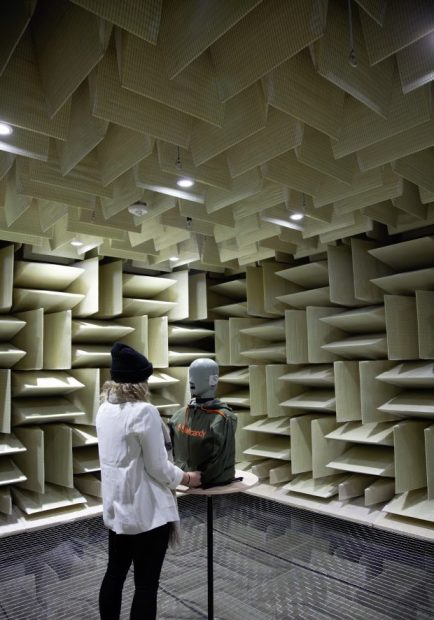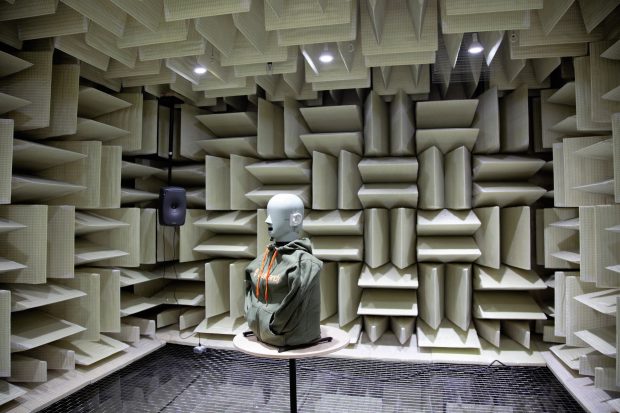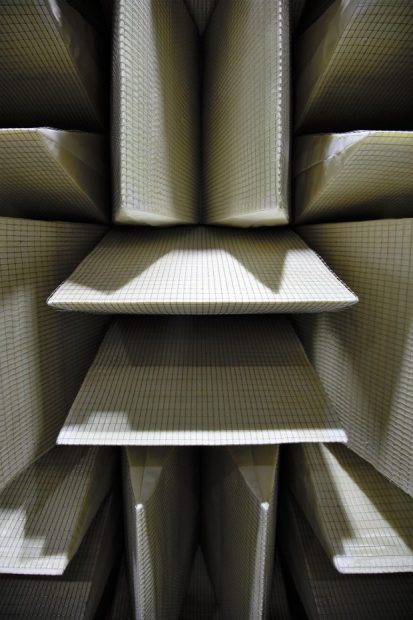
Image courtesy of Skullcandy, Inc.
Latest News
February 1, 2018
Headquartered in Park City, Utah, Skullcandy has grown into a global brand known for its lifestyle performance audio products. The modern company continues to grow, expanding its product lines and its R&D capabilities, while remaining true to its stated goal: “innovate to solve real problems and democratize amazing audio experiences with quality and style.”
 Skullcandy uses a Head and Torso Simulator (HATS) to test its new products. Image courtesy of Skullcandy, Inc.
Skullcandy uses a Head and Torso Simulator (HATS) to test its new products. Image courtesy of Skullcandy, Inc.Skullcandy aims to achieve high audio standards with each step it takes in product development. That’s why its leadership chose Eckel Noise Control Technologies (Eckel) of Cambridge, MA, to design and produce an anechoic chamber for product and component testing in the R&D area of its new headquarters. Skullcandy Director of Global Product Management Matt Windt said he went directly to Eckel because of the company’s reputation for performance and value.
“From our first conversation, it was obvious that Matt was very knowledgeable about our anechoic chambers, which made my job that much easier,” Eckel Vice President Jeff Morse says. “I met with Matt to discuss Skullcandy’s needs and our capabilities. When I showed him the video of our world record-breaking Microsoft chamber, that seemed to seal the deal.”
“It was great to have Jeff out to Park City to talk through our vision. He was able to quickly assess our needs and get the chamber specified within our performance and budget requirements,” adds Windt.
 The chamber is fitted with Eckel’s standard wedge design, whose dimensions determine the sound absorption level at different frequencies. Image courtesy of Skullcandy, Inc.
The chamber is fitted with Eckel’s standard wedge design, whose dimensions determine the sound absorption level at different frequencies. Image courtesy of Skullcandy, Inc.On February 20, 2017, Eckel’s installer—Viking Enterprises, led by Senior Superintendent David Engdall—began assembling the anechoic chamber at Skullcandy’s new headquarters in Park City. The process began with building the “host structure” or “box” that would contain the chamber and progressed through multiple steps, including creating the sub-floor panel system, an isolated sub-floor steel assembly and a spring-isolated stainless steel aircraft cable floor. The Viking team also assembled and erected the panels for the chamber walls and ceiling, and installed Eckel’s anechoic wedges on the sub-floor, wall and ceiling panels. The panels have integrated track systems onto which Eckel’s anechoic wedges are mounted. Engdall and his team made sure all chamber components were seamlessly incorporated into the Eckel design, which included meeting seismic requirements for its geographic location. Then, in a conversation between Engdall and Windt about chamber lighting, they struck upon the final—and one-of-a-kind—touch. Engdall envisioned creating a multi-color under-floor LED lighting system (see video here).
“I could totally see where David was going with his vision, and our brand needs to add our personal touch to everything, so this idea was perfect,” says Windt. “The LEDs are bright enough to allow for working in the chamber without the main lights on.”
On March 23, with the LEDs in place, Skullcandy had its finished anechoic chamber. Externally, it measures 22x20x17-ft. high. Internally (wedge-tip to wedge-tip), it’s 15 ft. 8 in. by 13 ft. 8 in. and 10 ft. 4 in. high. Skullcandy personnel can access the chamber through a 4x7-ft. combination wedge and sound door.
Tests on April 15 confirmed the chamber met the ISO 3745 standard and achieved 17dBA ambient sound and a 100-Hz frequency cutoff. The chamber will be used for testing frequency response, total harmonic distortion and intelligibility of Skullcandy components and products. The main focus is to have a consistent environment to do development testing and acoustic tuning, ranging from communication microphone development to earbud and headphone tuning to speaker tuning and driver development. The chamber’s uses are likely to grow and change with the company.
 Image courtesy of Skullcandy, Inc.
Image courtesy of Skullcandy, Inc.“Our products are constantly evolving; this is one of the strengths of our brand,” Windt says. “We are constantly reinventing what we consider ‘best’ and pushing that throughout our entire product line.”
“Our anechoic chamber is a massive step forward on improving all acoustic aspects of our products, and I believe it’s a superior chamber because we worked with Eckel,” Windt adds.
At press time, Skullcandy reported that it is using the chamber for testing related to new products that will be released in 2018 and 2019.
More Info
Subscribe to our FREE magazine, FREE email newsletters or both!
Latest News
Related Topics






